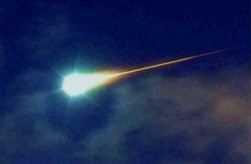 | ||
Meteorite falls, also called observed falls, are meteorites collected after their fall from space was observed by people or automated devices. All other meteorites are called "finds". There are more than 1,100 documented falls listed in widely used databases, most of which have specimens in modern collections. As of early 2017, the Meteoritical Bulletin Database has 1,149 confirmed falls (excluding rocks found nearby on the ground which turn out to not be associated with the fall and those with doubtful status).
Contents
Importance
Observed meteorite falls are interesting for several reasons.
Material from observed falls has not been subjected to terrestrial weathering, making the find a better candidate for scientific study. Historically, observed falls were the most compelling evidence supporting the extraterrestrial origin of meteorites. Furthermore, observed fall discoveries are a better representative sample of the types of meteorites which fall to Earth. For example, iron meteorites take much longer to weather and are easier to identify as unusual objects, as compared to other types. This may explain the increased proportion of iron meteorites among finds (6.7%), over that among observed falls (4.4%). There is also detailed statistics on falls such as based on meteorite classification.
As of early 2017, the Meteoritical Bulletin Database has 1,149 confirmed falls with statistics for the previous decades as,
For 2016, five falls have been confirmed: Osceola (Jan), Mount Blanco (Feb), Ejby (Feb), Stubenberg (Mar), and Banma (Aug).
Oldest
The German physicist Ernst Cladni, sometimes considered as the father of meteoritics, was the first to publish (in 1794) the then audacious idea that meteorites were rocks from space. There were already several documented cases, one of the earliest was the Aegospotami meteorite of 467 BC and which became a landmark for 500 years.
Below is a list of 8 confirmed falls pre-1600 AD. However, unlike the Loket (Elbogen) and Ensisheim meteorites, not all are as well-documented.
Largest
While most confirmed falls involve masses between less than one kg to several kg, some reach 100 kg or more. A few are even more than one metric ton. The six largest falls are listed below and five (except the 2013 Chelyabinsk meteorite) occurred during the 20th century. Presumably, events of such magnitude may happen a few times per century but, especially if it occurred in remote areas, may have gone unreported.
For comparison, the largest finds are the 60-ton Hoba meteorite, a 37-ton fragment (El Chaco) of the Campo del Cielo, a 30.9-ton fragment (Ahnighito) of the Cape York meteorite, and a 30.8-ton fragment (Gancedo) of the Campo del Cielo.
Recent
These 14 have been found in 2010 and after. Since in the modern period around half a dozen falls are normally found each year, the table needs some updating.
Others
These have all been found between 1610-2010 and arranged alphabetically (mostly).
